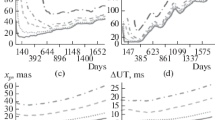Abstract.
Earth orientation parameters (EOPs) [polar motion and length of day (LOD), or UT1–UTC] were predicted by artificial neural networks. EOP series from various sources, e.g. the C04 series from the International Earth Rotation Service and the re-analysis optical astrometry series based on the HIPPARCOS frame, served for training the neural network for both short-term and long-term predictions. At first, all effects which can be described by functional models, e.g. effects of the solid Earth tides and the ocean tides or seasonal atmospheric variations of the EOPs, were removed. Only the differences between the modeled and the observed EOPs, i.e. the quasi-periodic and irregular variations, were used for training and prediction. The Stuttgart neural network simulator, which is a very powerful software tool developed at the University of Stuttgart, was applied to construct and to validate different types of neural networks in order to find the optimal topology of the net, the most economical learning algorithm and the best procedure to feed the net with data patterns. The results of the prediction were analyzed and compared with those obtained by other methods. The accuracy of the prediction is equal to or even better than that by other prediction methods.
Similar content being viewed by others
Author information
Authors and Affiliations
Additional information
Received: 6 February 2001 / Accepted: 23 October 2001
Rights and permissions
About this article
Cite this article
Schuh, H., Ulrich, M., Egger, D. et al. Prediction of Earth orientation parameters by artificial neural networks. Journal of Geodesy 76, 247–258 (2002). https://doi.org/10.1007/s00190-001-0242-5
Issue Date:
DOI: https://doi.org/10.1007/s00190-001-0242-5




